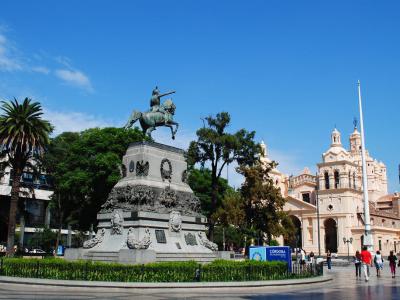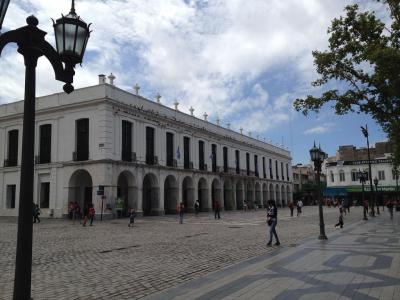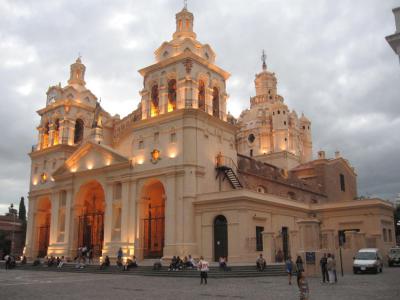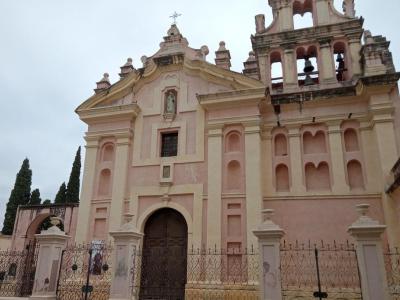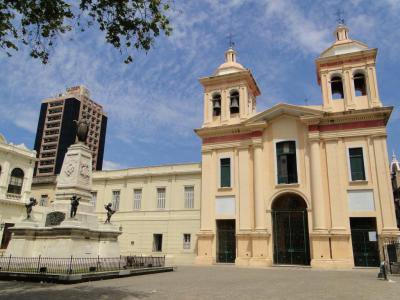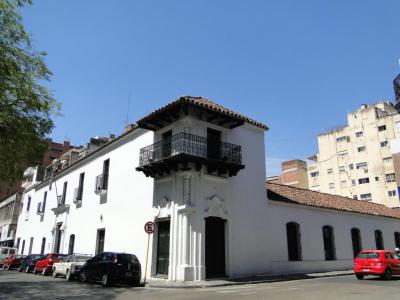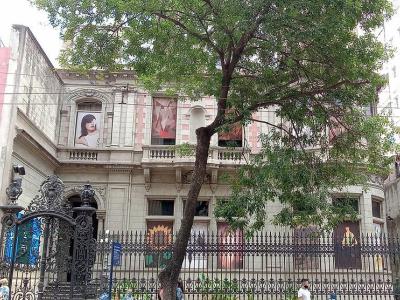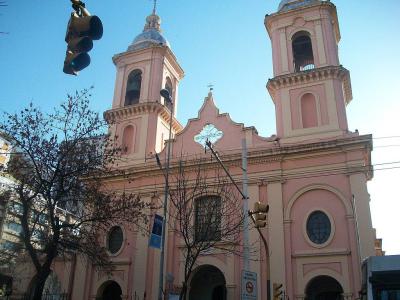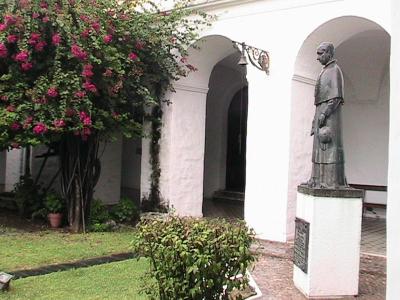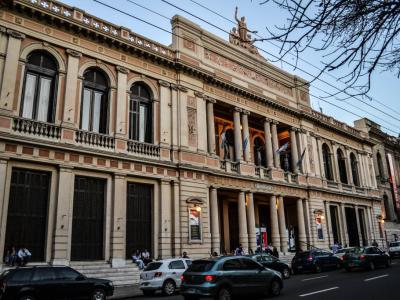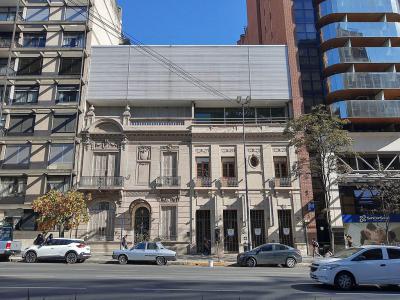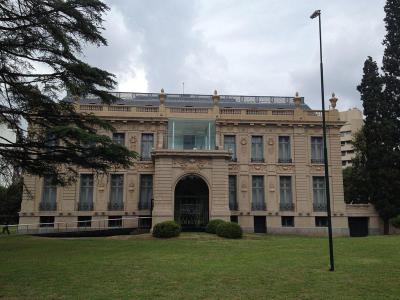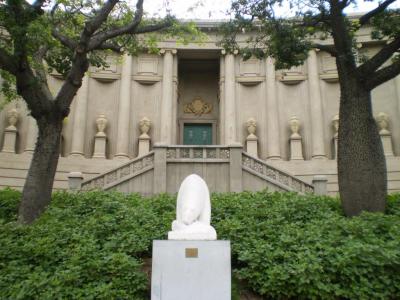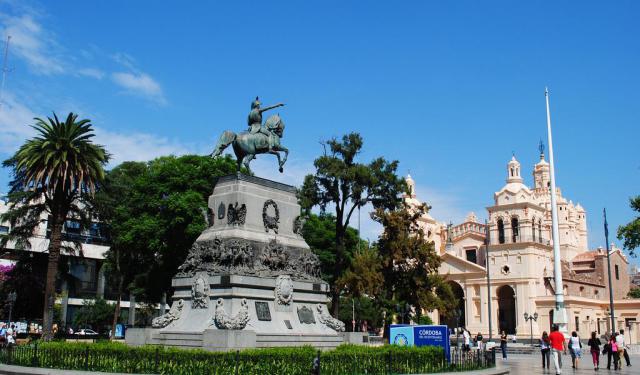
Cordoba Introduction Walking Tour (Self Guided), Cordoba
Capital of the eponymous Argentinean province, Córdoba is famous for its colonial-era architecture. The key landmark here is undoubtedly Plaza San Martín flanked by neo-baroque Córdoba Cathedral. To appreciate these and other beauties of Córdoba, follow this orientation walk and enjoy!
How it works: Download the app "GPSmyCity: Walks in 1K+ Cities" from Apple App Store or Google Play Store to your mobile phone or tablet. The app turns your mobile device into a personal tour guide and its built-in GPS navigation functions guide you from one tour stop to next. The app works offline, so no data plan is needed when traveling abroad.
Cordoba Introduction Walking Tour Map
Guide Name: Cordoba Introduction Walking Tour
Guide Location: Argentina » Cordoba (See other walking tours in Cordoba)
Guide Type: Self-guided Walking Tour (Sightseeing)
# of Attractions: 13
Tour Duration: 2 Hour(s)
Travel Distance: 3.4 Km or 2.1 Miles
Author: StaceyP
Sight(s) Featured in This Guide:
Guide Location: Argentina » Cordoba (See other walking tours in Cordoba)
Guide Type: Self-guided Walking Tour (Sightseeing)
# of Attractions: 13
Tour Duration: 2 Hour(s)
Travel Distance: 3.4 Km or 2.1 Miles
Author: StaceyP
Sight(s) Featured in This Guide:
- Plaza San Martin
- Cabildo
- Córdoba Cathedral
- Iglesia y Convento de las Teresas
- Iglesia y Convento San Francisco
- Museo-Casa del Virrey Sobremonte
- Museo Municipal de Bellas Artes Dr Genaro Pérez
- Iglesia de Santo Domingo
- Museo San Alberto (St. Albert Museum)
- Libertador Theatre
- Museo de Antropologia (Museum of Anthropology)
- Evita Fine Arts Museum
- Caraffa Fine Arts Museum
1) Plaza San Martin (must see)
Plaza San Martin is the most popular square in Cordoba and is located in the heart of the city. This lively place organizes fairs and exhibitions. In the middle of the park there is a statue of the General San Martin. Next to the plaza there is a colonial-style cathedral and a 17th-century cabildo. The plaza dates back to the 1577.
2) Cabildo (must see)
The Córdoba Cabildo was the colonial town hall of Córdoba. Encinas' cabildo, which included only the Alcalde's office, living quarters and a small jail, was ordered replaced by a larger building in 1749 by the Alcade (Mayor), José Moyano Oscariz. The Governor of Córdoba appointed in 1783, the Marquess of Sobremonte, Rafael Núñez, prioritized the much delayed completion of the new Cabildo. He commissioned Juan Manuel López for the new project, which would feature a significantly larger office space, grand steps, a chapel, a patio, an archway of fifteen columns along the façade, and a covered arcade along the archway for the inclusion of storefronts. The greatly accelerated works were concluded in 1786, and would include the opening of the Santa Catalina Promenade between the cabildo and the recently built Córdoba Cathedral.
Marble cladding and a bell tower were added in 1885, though the latter was removed during the cabildo's restoration in the late 1930s, when numerous historic structures in Argentina were restored to their approximate, original design by having such additions demolished. The city government was relocated to a Renaissance Revivalist structure late in the 19th century, and to a Modernist building in the 1960s. A section of the historic cabildo remained in use by the Provincial Police Department of Information (DDI), however, and during the last dictatorship, this wing was used as one of over 300 detention centers operated by the regime during the Dirty War of the late 1970s.
Marble cladding and a bell tower were added in 1885, though the latter was removed during the cabildo's restoration in the late 1930s, when numerous historic structures in Argentina were restored to their approximate, original design by having such additions demolished. The city government was relocated to a Renaissance Revivalist structure late in the 19th century, and to a Modernist building in the 1960s. A section of the historic cabildo remained in use by the Provincial Police Department of Information (DDI), however, and during the last dictatorship, this wing was used as one of over 300 detention centers operated by the regime during the Dirty War of the late 1970s.
Sight description based on Wikipedia.
3) Córdoba Cathedral (must see)
The Córdoba Cathedral is the central church of the Roman Catholic Archdiocese of Córdoba, and the oldest church in continuous service in Argentina. Construction on the original church, the Iglesia de Nuestra Señora de la Asunción began in 1598. Its early works were planned by architect Nicolás de Dios, public works director Gregorio Ferreira, and master mason Juan Rodríguez, who employed mostly indigenous artisans and laborers. Beams and rafters were planned by Mateo Domínguez, and Hernando Álvarez designed and oversaw installation of the roof's 30,000 mission tiles.
Much of the initial structure was lost in a 1677 collapse. The incomplete church was inaugurated in 1709. Further additions included the cupola, designed by Franciscan Friar Vicente Muñoz, the Spanish Baroque façade and the Neoclassical portico were designed in 1729 by Italian architect Andrea Blanqui. The cathedral was consecrated by Bishop José Antonio de San Alberto in 1784, and the twin campaniles were completed in 1787. The cathedral is separated from the Córdoba Cabildo by the Santa Catalina Promenade.
The ornate interior, overlooked by the sterling silver altar crafted in Colonial Peru, also includes a church tabernacle donated to the cathedral in 1804, as well as an extensive collection of silver and gold votive offerings. The interior was later decorated with frescoes and murals painted in the early years of the 20th century by Emilio Caraffa, Carlos Camilloni, and Manuel Cardeñosa; a cast iron monument, Cristo Redentor was installed above the portico in 1901.
Much of the initial structure was lost in a 1677 collapse. The incomplete church was inaugurated in 1709. Further additions included the cupola, designed by Franciscan Friar Vicente Muñoz, the Spanish Baroque façade and the Neoclassical portico were designed in 1729 by Italian architect Andrea Blanqui. The cathedral was consecrated by Bishop José Antonio de San Alberto in 1784, and the twin campaniles were completed in 1787. The cathedral is separated from the Córdoba Cabildo by the Santa Catalina Promenade.
The ornate interior, overlooked by the sterling silver altar crafted in Colonial Peru, also includes a church tabernacle donated to the cathedral in 1804, as well as an extensive collection of silver and gold votive offerings. The interior was later decorated with frescoes and murals painted in the early years of the 20th century by Emilio Caraffa, Carlos Camilloni, and Manuel Cardeñosa; a cast iron monument, Cristo Redentor was installed above the portico in 1901.
Sight description based on Wikipedia.
4) Iglesia y Convento de las Teresas (must see)
Situated only half a block from Plaza San Martin and in the historic center of Cordoba, the Church of the Teresas features colors, beautiful architecture and a historic heritage that dates back to the early days of the city. The church was founded in 1625. Its design was created by Andrés Blanqui. The convent has seven courtyards, an old chapel and the cemetery.
5) Iglesia y Convento San Francisco (must see)
Iglesia y Convento San Francisco was built in Neoclassical style. It was founded in 1813 and designed by Juan Manuel Lopez. The church's facade shows its Italian style. The interior is made in Baroque style and ornamented with paintings from the 17th, 18th and 19th centuries. The furniture inside the church dates back to the 16th century. The church belongs to the order of the Franciscans which is why the church is so richly decorated.
6) Museo-Casa del Virrey Sobremonte
Museo-Casa del Virrey Sobremonte is located in the district of Lujan on Rosario de Santa-Fe street. It claims to be the most beautiful colonial house in Cordoba. In 1752 this house was the home of Marquis de Sobremonte. It was declared a National Historic Landmark and has great historic importance. The museum includes a chapel and a courtyard, and preserves furniture and objects of great value.
7) Museo Municipal de Bellas Artes Dr Genaro Pérez
Museo Municipal de Bellas Artes Dr Genaro Pérez was established in 1943. The design of the building in which the museum is housed was crated by Lanusse and Harry in 1905 in the French style. The museum's permanent collection consists of paintings from the 19th and 20th centuries. There are exhibited works by the greatest Argentinian artists such as Emilio Caraffa, Lucio Fontana and Antonio Berni. The museum is open daily, Tuesday to Sunday from 10:00 a.m. to 8:00 p.m.
8) Iglesia de Santo Domingo
Iglesia de Santo Domingo was established in 1861 and is located in the heart of the city. It underwent several changes throughout the years. The design of the church is simplified, its façade having features of the Renaissance style. The domes of the temple look with a majestic air over the city.
9) Museo San Alberto (St. Albert Museum)
Museo San Alberto is a museum located in front of the Jesuit Block. It was initially the place of the Royal Convictorio of Our Lady of Montserrat and the Royal House of Nobles. In the basement of the building was the first printing of the Viceroyalty of Río de la Plata, established by the Jesuits in the 18th century. There are many pieces of art, images, tools, and furniture that recall the Cordoba colonial life.
10) Libertador Theatre
The Libertador San Martín Theatre is the premier stage theatre, opera house and concert hall in Córdoba. The landmark institution was inaugurated on April 26, 1891, as the Rivera Indarte Theatre. Popularly known as the Teatro de la Calle Ancha ("Broad Street Theatre") during the early 20th century, the grand concert hall was designed for a capacity of 1,000 spectators. Its concert hall featured a rising floor to stage level, made available during the many social balls held there since then. Among the first prominent drama theatre directors to stage productions there was María Guerrero, who popularized the theatre of Spain in Argentina after 1897. Subsequent years saw numerous internationally renowned classical performers, as well, notably Enrico Caruso, Titta Ruffo, Tito Schipa and Arthur Rubinstein.
The theatre additionally houses the Luis de Tejeda and Rafael Grisolía halls, each with capacities of around 100 and mainly reserved for seminars, as well as for the theatre's Youth Orchestra. A museum of the institution's extensive stagecraft collection was organized into the Cristóbal de Aguilar Musical and Theatre Museum in 1970.
The institution was renamed in honor of General José de San Martín in 1950 by order of President Juan Perón on the occasion of the centennial of the Liberator's death.
The theatre additionally houses the Luis de Tejeda and Rafael Grisolía halls, each with capacities of around 100 and mainly reserved for seminars, as well as for the theatre's Youth Orchestra. A museum of the institution's extensive stagecraft collection was organized into the Cristóbal de Aguilar Musical and Theatre Museum in 1970.
The institution was renamed in honor of General José de San Martín in 1950 by order of President Juan Perón on the occasion of the centennial of the Liberator's death.
Sight description based on Wikipedia.
11) Museo de Antropologia (Museum of Anthropology)
Museo de Antropologia is an institution of scientific education. Its aim is to collect, preserve and exhibit the culture of humanity and society, ancient and contemporary. The museum is located at the National University of Cordoba, Faculty of Philosophy and Sciences. The museum encourages respect of other cultures and lifestyles in order to enhance and develop cultural heritage.
12) Evita Fine Arts Museum (must see)
The Evita Fine Arts Museum is an art museum in Córdoba housed in the Ferreyra Palace, a Beaux-Arts mansion designed by French architect Ernest Sanson and built between 1912 and 1916 for Dr. Martín Ferreyra, a prominent local physician and surgeon.
Ferreyra chose the spot as a result of the development of the adjacent Sarmiento Park, a 17 hectare (43 acre) space created along what was then Córdoba's eastern edge (New Córdoba) and inaugurated in 1911. Subsequent generations added to the palace's interiors, notably the Imperial Bedroom (Dormitorio Imperio), so named because the furniture was copied by famed cabinetmaker Krieger of Paris, from those used by Napoleon Bonaparte.
The museum maintains 12 exhibit halls, a sculpture garden, library, and an auditorium for 120. Its collection of over 500 works includes those by Emilio Caraffa, Juan Carlos Castagnino, Gustave Courbet, Pablo Picasso, Joaquín Sorolla, Lino Enea Spilimbergo and Ricardo Supisiche, among others. The museum hosts ongoing temporary exhibits, as well.
Ferreyra chose the spot as a result of the development of the adjacent Sarmiento Park, a 17 hectare (43 acre) space created along what was then Córdoba's eastern edge (New Córdoba) and inaugurated in 1911. Subsequent generations added to the palace's interiors, notably the Imperial Bedroom (Dormitorio Imperio), so named because the furniture was copied by famed cabinetmaker Krieger of Paris, from those used by Napoleon Bonaparte.
The museum maintains 12 exhibit halls, a sculpture garden, library, and an auditorium for 120. Its collection of over 500 works includes those by Emilio Caraffa, Juan Carlos Castagnino, Gustave Courbet, Pablo Picasso, Joaquín Sorolla, Lino Enea Spilimbergo and Ricardo Supisiche, among others. The museum hosts ongoing temporary exhibits, as well.
Sight description based on Wikipedia.
13) Caraffa Fine Arts Museum (must see)
The Emilio Caraffa Provincial Fine Arts Museum was established as the Provincial Fine Arts Museum by the Province of Córdoba, which commissioned German Argentine architect Juan Kronfuss for its design, in 1915. Built on the western edge of the newly-inaugurated Sarmiento Park, the work of Neoclassical architecture was completed in 1916, and originally included 255 m² and one exhibit hall, the Kronfuss Salon. The Provincial Museum was renamed in honor of local artist Emilio Caraffa, in 1950, and new wings completed in 1962 and 2007 brought the museum's display area to 1,500 m², distributed among nine exhibit halls.
Aside from those of its namesake, the museum maintains paintings and sculptures by other renowned local artists such as Juan Carlos Castagnino, Pablo Curatella Manes, Fernando Fader, Emilio Pettoruti, Lino Enea Spilimbergo, as well as lithographs by Pablo Picasso and paintings by Tsuguharu Foujita and Francisco Goya. The museum also hosts temporary exhibits and includes the provincial art archive and restoration workshop, as well as a library and educational facilities.
Aside from those of its namesake, the museum maintains paintings and sculptures by other renowned local artists such as Juan Carlos Castagnino, Pablo Curatella Manes, Fernando Fader, Emilio Pettoruti, Lino Enea Spilimbergo, as well as lithographs by Pablo Picasso and paintings by Tsuguharu Foujita and Francisco Goya. The museum also hosts temporary exhibits and includes the provincial art archive and restoration workshop, as well as a library and educational facilities.
Sight description based on Wikipedia.
Walking Tours in Cordoba, Argentina
Create Your Own Walk in Cordoba
Creating your own self-guided walk in Cordoba is easy and fun. Choose the city attractions that you want to see and a walk route map will be created just for you. You can even set your hotel as the start point of the walk.
Cordoba Shopping Tour
Argentina is well-known for its leather goods throughout the world, but Cordoba is known for its shops that sell a variety of handicrafts made by the local artisans, in addition to leather items. There are also gift shops where you will be able to buy a souvenir to take back home. Take this walking tour to drop in on some of the most interesting shops in Cordoba.
Tour Duration: 1 Hour(s)
Travel Distance: 2.7 Km or 1.7 Miles
Tour Duration: 1 Hour(s)
Travel Distance: 2.7 Km or 1.7 Miles
Top Religious Sites
The city of Cordoba has many places of worship of different faiths and denominations, including Catholic churches, synagogues and mosques. The central masterpiece of the city is the Cordoba Cathedral, standing majestically in the very heart of the city. Take this tour to get acquainted with the religious life in Cordoba.
Tour Duration: 1 Hour(s)
Travel Distance: 2.2 Km or 1.4 Miles
Tour Duration: 1 Hour(s)
Travel Distance: 2.2 Km or 1.4 Miles
The Most Popular Cities
/ view all
